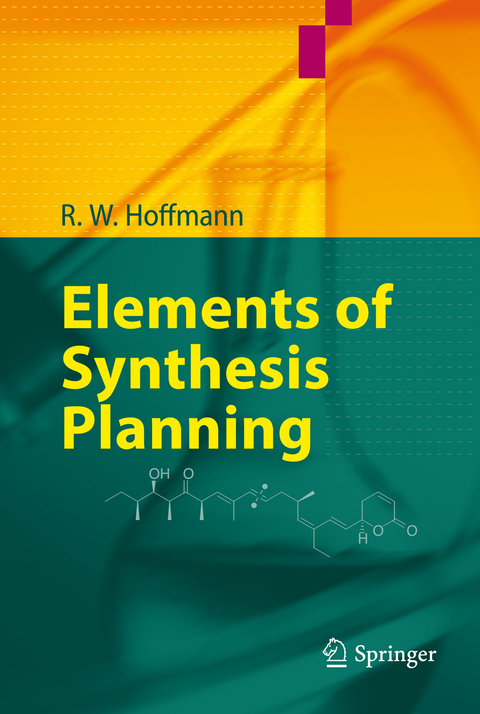
Elements of Synthesis Planning
Springer Berlin (Verlag)
9783540792192 (ISBN)
Functional Group Oriented Bond-Sets.- Skeleton Oriented Bond-Sets.- Building Block Oriented Synthesis.- The Basis for Planning.- Formation of Cyclic Structures.- Protecting Groups.- Ranking of Synthesis Plans.- Computer-Aided Synthesis Planning.- Stereogenic Centers and Planning of Syntheses.- Enjoying the Art of Synthesis.- Summary and Concluding Remarks.- Solutions to Problems.
From the reviews:
"The text is recommended for those with a strong foundation in organic chemistry. ... The book would be quite helpful for those who plan syntheses on a regular basis ... . The text is a useful addition to the library of any synthetic organic chemist or to select undergraduate and graduate curricula. ... Readers will certainly learn more about the chemistry, the logic, and the art of planning a novel synthesis and contributing to a vast and interesting field." (Bridget G. Trogden, Journal of Chemical Education, Vol. 88, 2011)
From an undergraduate learning perspective the concept of synthesis planning or retrosynthesis can appear to be a daunting prospect. The idea of being asked to think backwards for many is a big leap, despite the vast majority already possessing a well-stocked chemical toolbox and being more than capable to explain a multitude of complex mechanistic transformations. In Elements of synthesis planning, a reworked translation of his original German text, Reinhard Hoffmann sets out to 'demystify' the art of synthetic planning, which is an essential and vital skill practised every day throughout the worldwide organic chemistry community.
In 12 clear and logical chapters, Hoffmann takes the reader from the basic concepts of retrosynthesis (use of synthons, identifying key bond disconnections, unmasking symmetry elements etc) to dedicated chapters on the application of chiral building blocks, strategic planning of complex synthetic sequences and the synthesis of polycyclic ring systems. In the final chapter, all these concepts are brought together to elegantly compare several individual approaches to one of five representative natural products, highlighting the tactics and strategies employed.
As such, this text would ideally complement an advanced undergraduate course on complex organic synthesis, which is beyond the level of most standard organic chemistrytextbooks. It would also prove highly useful to postgraduates at the beginning of their research careers in synthesis to inspire creativity and maybe put their ideas into practice.
Gordon Florence , Chemistry World, 2009, 6(8), p. 63
From the reviews:“The text is recommended for those with a strong foundation in organic chemistry. … The book would be quite helpful for those who plan syntheses on a regular basis … . The text is a useful addition to the library of any synthetic organic chemist or to select undergraduate and graduate curricula. … Readers will certainly learn more about the chemistry, the logic, and the art of planning a novel synthesis and contributing to a vast and interesting field.” (Bridget G. Trogden, Journal of Chemical Education, Vol. 88, 2011)From an undergraduate learning perspective the concept of synthesis planning or retrosynthesis can appear to be a daunting prospect. The idea of being asked to think backwards for many is a big leap, despite the vast majority already possessing a well-stocked chemical toolbox and being more than capable to explain a multitude of complex mechanistic transformations. In Elements of synthesis planning, a reworked translation of his original German text, Reinhard Hoffmann sets out to 'demystify' the art of synthetic planning, which is an essential and vital skill practised every day throughout the worldwide organic chemistry community. In 12 clear and logical chapters, Hoffmann takes the reader from the basic concepts of retrosynthesis (use of synthons, identifying key bond disconnections, unmasking symmetry elements etc) to dedicated chapters on the application of chiral building blocks, strategic planning of complex synthetic sequences and the synthesis of polycyclic ring systems. In the final chapter, all these concepts are brought together to elegantly compare several individual approaches to one of five representative natural products, highlighting the tactics and strategies employed. As such, this text would ideally complement an advanced undergraduate course on complex organic synthesis, which is beyond the level of most standard organic chemistrytextbooks. It would also prove highly useful to postgraduates at the beginning of their research careers in synthesis to inspire creativity and maybe put their ideas into practice. Gordon Florence , Chemistry World, 2009, 6(8), p. 63
| Erscheint lt. Verlag | 21.1.2009 |
|---|---|
| Zusatzinfo | X, 227 p. 297 illus. |
| Verlagsort | Berlin |
| Sprache | englisch |
| Maße | 155 x 235 mm |
| Gewicht | 365 g |
| Themenwelt | Medizin / Pharmazie ► Pharmazie |
| Naturwissenschaften ► Biologie ► Biochemie | |
| Naturwissenschaften ► Chemie ► Organische Chemie | |
| Schlagworte | biochemistry • Chemistry • medicinal chemistry • Organic Chemistry • Skeleton • Synthese (chem.) • synthesis |
| ISBN-13 | 9783540792192 / 9783540792192 |
| Zustand | Neuware |
| Informationen gemäß Produktsicherheitsverordnung (GPSR) | |
| Haben Sie eine Frage zum Produkt? |
aus dem Bereich


